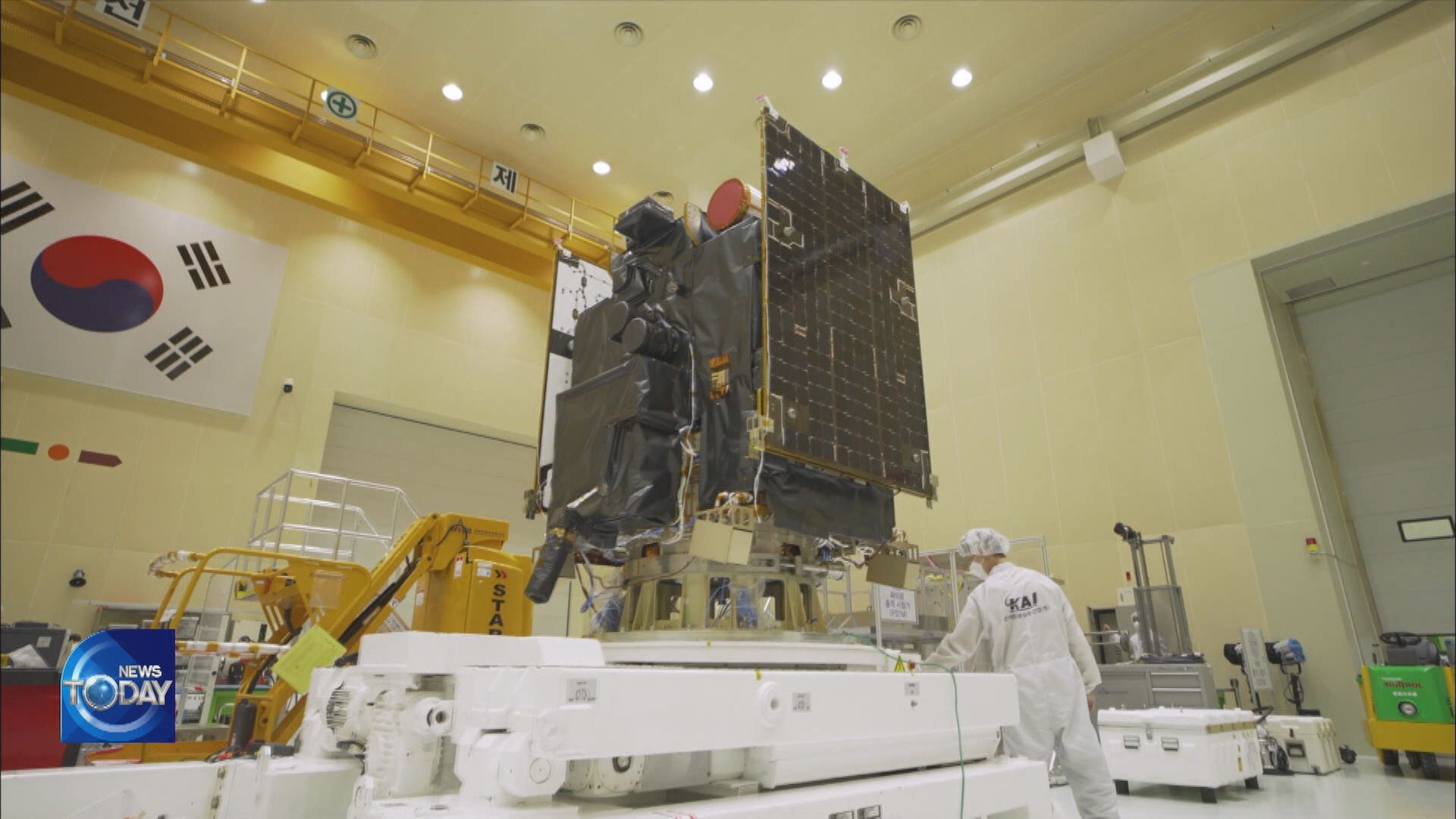S. KOREA'S FIRST LUNAR ORBITER
입력 2022.01.05 (15:14)
수정 2022.01.05 (17:02)
읽어주기 기능은 크롬기반의
브라우저에서만 사용하실 수 있습니다.
[Anchor Lead]
After launching its first homegrown space rocket, Korea is about to introduce its first domestic lunar orbiter. If its launch goes successfully this year, it will set a milestone in the nation's space development efforts.
[Pkg]
South Korea has been developing the Korean Pathfinder Lunar Orbiter, since 2016. Its undergoing an electromagnetic environment and solar panel tests ahead of its launch slated for August. Last year its integration and orbit environment tests were completed without mishaps. The lunar orbiter is equipped with five domestic devices, including a high-resolution camera, and NASA's Shadow Cam needed to secure data for landing piloted lunar explorers. Once the orbiter and all its devices are tested, it will be transported to a launch site.
[Soundbite] Gu Hyun-mo(Korea Aerospace Research Institute) : "We will prepare to transport the orbiter to a launch site from May and launch it into space on August 1 by loading it onto the Space X Falcon 9."
If the launch goes successfully, the KPLO will first orbit at 1.5 million kilometers from the Earth before settling down in the lunar orbit 380,000 km from the Earth later this year using terrestrial and lunar gravity. It will then orbit like a satellite for one year at 100 km from the lunar surface.
[Soundbite] Jeon Moon-jin(Korea Aerospace Research Institute) : "We plan to load devices for exploring the lunar surface and environment as well as for checking conditions for space internet to be used in the future."
If the first homegrown lunar orbiter accomplishes its mission successfully, Korea will launch its own project for sending an unmanned space probe to the Moon in 2030.
After launching its first homegrown space rocket, Korea is about to introduce its first domestic lunar orbiter. If its launch goes successfully this year, it will set a milestone in the nation's space development efforts.
[Pkg]
South Korea has been developing the Korean Pathfinder Lunar Orbiter, since 2016. Its undergoing an electromagnetic environment and solar panel tests ahead of its launch slated for August. Last year its integration and orbit environment tests were completed without mishaps. The lunar orbiter is equipped with five domestic devices, including a high-resolution camera, and NASA's Shadow Cam needed to secure data for landing piloted lunar explorers. Once the orbiter and all its devices are tested, it will be transported to a launch site.
[Soundbite] Gu Hyun-mo(Korea Aerospace Research Institute) : "We will prepare to transport the orbiter to a launch site from May and launch it into space on August 1 by loading it onto the Space X Falcon 9."
If the launch goes successfully, the KPLO will first orbit at 1.5 million kilometers from the Earth before settling down in the lunar orbit 380,000 km from the Earth later this year using terrestrial and lunar gravity. It will then orbit like a satellite for one year at 100 km from the lunar surface.
[Soundbite] Jeon Moon-jin(Korea Aerospace Research Institute) : "We plan to load devices for exploring the lunar surface and environment as well as for checking conditions for space internet to be used in the future."
If the first homegrown lunar orbiter accomplishes its mission successfully, Korea will launch its own project for sending an unmanned space probe to the Moon in 2030.
■ 제보하기
▷ 카카오톡 : 'KBS제보' 검색, 채널 추가
▷ 전화 : 02-781-1234, 4444
▷ 이메일 : kbs1234@kbs.co.kr
▷ 유튜브, 네이버, 카카오에서도 KBS뉴스를 구독해주세요!
- S. KOREA'S FIRST LUNAR ORBITER
-
- 입력 2022-01-05 15:14:43
- 수정2022-01-05 17:02:03

[Anchor Lead]
After launching its first homegrown space rocket, Korea is about to introduce its first domestic lunar orbiter. If its launch goes successfully this year, it will set a milestone in the nation's space development efforts.
[Pkg]
South Korea has been developing the Korean Pathfinder Lunar Orbiter, since 2016. Its undergoing an electromagnetic environment and solar panel tests ahead of its launch slated for August. Last year its integration and orbit environment tests were completed without mishaps. The lunar orbiter is equipped with five domestic devices, including a high-resolution camera, and NASA's Shadow Cam needed to secure data for landing piloted lunar explorers. Once the orbiter and all its devices are tested, it will be transported to a launch site.
[Soundbite] Gu Hyun-mo(Korea Aerospace Research Institute) : "We will prepare to transport the orbiter to a launch site from May and launch it into space on August 1 by loading it onto the Space X Falcon 9."
If the launch goes successfully, the KPLO will first orbit at 1.5 million kilometers from the Earth before settling down in the lunar orbit 380,000 km from the Earth later this year using terrestrial and lunar gravity. It will then orbit like a satellite for one year at 100 km from the lunar surface.
[Soundbite] Jeon Moon-jin(Korea Aerospace Research Institute) : "We plan to load devices for exploring the lunar surface and environment as well as for checking conditions for space internet to be used in the future."
If the first homegrown lunar orbiter accomplishes its mission successfully, Korea will launch its own project for sending an unmanned space probe to the Moon in 2030.
After launching its first homegrown space rocket, Korea is about to introduce its first domestic lunar orbiter. If its launch goes successfully this year, it will set a milestone in the nation's space development efforts.
[Pkg]
South Korea has been developing the Korean Pathfinder Lunar Orbiter, since 2016. Its undergoing an electromagnetic environment and solar panel tests ahead of its launch slated for August. Last year its integration and orbit environment tests were completed without mishaps. The lunar orbiter is equipped with five domestic devices, including a high-resolution camera, and NASA's Shadow Cam needed to secure data for landing piloted lunar explorers. Once the orbiter and all its devices are tested, it will be transported to a launch site.
[Soundbite] Gu Hyun-mo(Korea Aerospace Research Institute) : "We will prepare to transport the orbiter to a launch site from May and launch it into space on August 1 by loading it onto the Space X Falcon 9."
If the launch goes successfully, the KPLO will first orbit at 1.5 million kilometers from the Earth before settling down in the lunar orbit 380,000 km from the Earth later this year using terrestrial and lunar gravity. It will then orbit like a satellite for one year at 100 km from the lunar surface.
[Soundbite] Jeon Moon-jin(Korea Aerospace Research Institute) : "We plan to load devices for exploring the lunar surface and environment as well as for checking conditions for space internet to be used in the future."
If the first homegrown lunar orbiter accomplishes its mission successfully, Korea will launch its own project for sending an unmanned space probe to the Moon in 2030.
이 기사가 좋으셨다면
-
좋아요
0
-
응원해요
0
-
후속 원해요
0














![[단독] 김민석 총리, 취임 첫 일정으로 ‘송미령 반대’ 농민단체 농성장 방문](/data/news/2025/07/03/20250703_YUTdgQ.png)
![[단독] ‘스테로이드’부터 ‘임신중지약’까지…해외 의약품 불법 유통 11만 건](/data/news/2025/07/03/20250703_qpUU1y.png)

이 기사에 대한 의견을 남겨주세요.